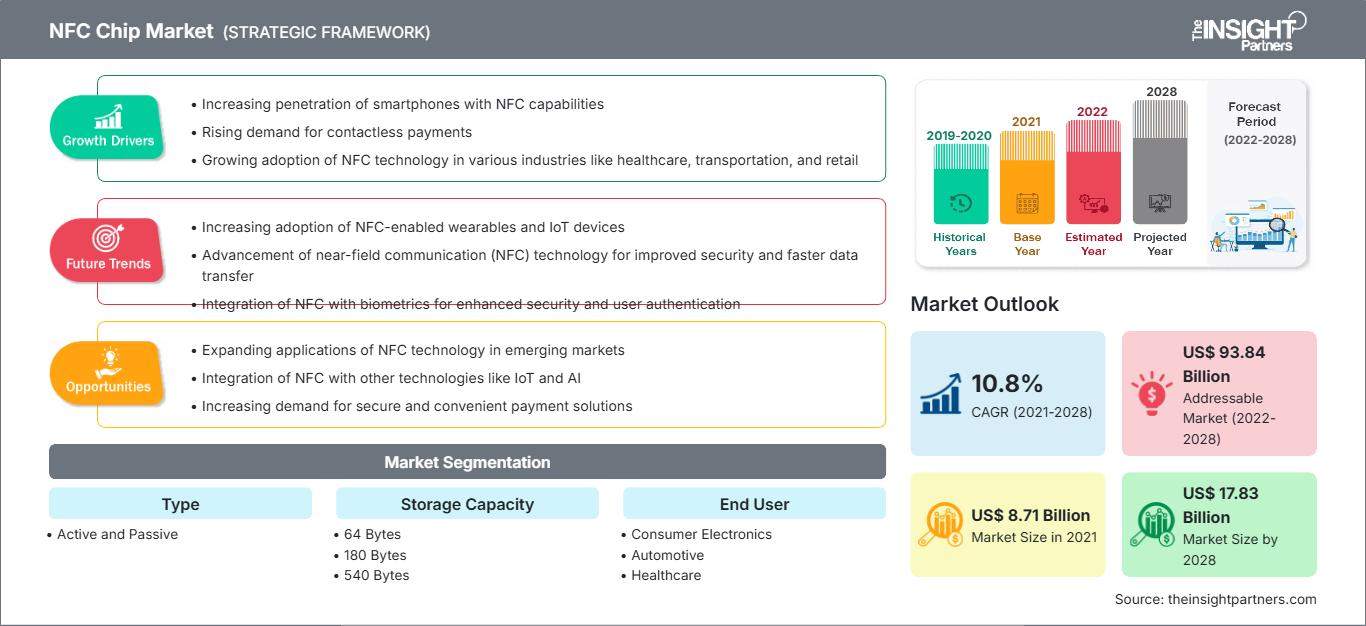Se espera que el mercado de chips NFC crezca de US$ 8.714,4 millones en 2021 a US$ 17.827,0 millones en 2028; se estima que crecerá a una CAGR del 10,8% durante 2021-2028.
Los teléfonos inteligentes se han convertido en un componente integral de la vida de los consumidores actuales. Los consumidores utilizan sus teléfonos celulares para realizar pagos cada vez más rápidos, además de las formas tradicionales de comunicación. NFC es un medio de pago conveniente, ya que integra el dispositivo móvil del consumidor con su billetera. Permite a los usuarios realizar transacciones móviles, intercambiar material digital rápidamente y conectar sus dispositivos con otros dispositivos mediante el tacto. Como resultado, el número de dispositivos equipados con tecnología NFC está creciendo, lo que contribuye a su expansión y popularidad en los mercados emergentes. Los chips NFC facilitan el uso de las interfaces de usuario, haciéndolas más útiles en los productos de consumo. Fabricantes de teléfonos inteligentes, como Apple y Samsung, incluyen chips NFC en sus terminales, lo que resulta en una mayor demanda de chips NFC entre los fabricantes de teléfonos móviles. Con el aumento del uso de teléfonos inteligentes, la penetración de NFC también aumentará, lo que impulsará el crecimiento del mercado de chips NFC.
Además, la creciente adopción de la digitalización y las tecnologías de comunicación mejoradas impulsa la demanda de chips NFC. Android Beam, por ejemplo, es una función presente en todos los smartphones Android con NFC. Los usuarios pueden intercambiar archivos multimedia y contactos con otro smartphone Android simplemente manteniendo sus teléfonos cerca. Dado que la tecnología NFC consume menos energía y, en ocasiones, puede funcionar sin electricidad, es una forma cómoda de compartir archivos digitales. Estos factores están generando un impacto positivo en el crecimiento del mercado de chips NFC.
La tecnología NFC también funciona en modo peer-to-peer, además de para los pagos móviles y la distribución inteligente de información. Permite que dos smartphones intercambien contactos, actividades del calendario, enlaces a sitios web, imágenes e incluso videoclips, de forma similar a Bluetooth y Wi-Fi Direct. La tecnología NFC es una solución prometedora para el intercambio y el comercio, y los pequeños comercios minoristas mejoran sus ganancias al ofrecer transacciones fluidas y sencillas a sus clientes. Los beneficios mencionados anteriormente relacionados con la tecnología NFC están generando oportunidades de negocio lucrativas para el crecimiento del mercado de chips NFC.
Personalice este informe según sus necesidades
Obtendrá personalización en cualquier informe, sin cargo, incluidas partes de este informe o análisis a nivel de país, paquete de datos de Excel, así como también grandes ofertas y descuentos para empresas emergentes y universidades.
Mercado de chips NFC: Perspectivas estratégicas

-
Obtenga las principales tendencias clave del mercado de este informe.Esta muestra GRATUITA incluirá análisis de datos, desde tendencias del mercado hasta estimaciones y pronósticos.
Impacto de la pandemia de COVID-19 en el mercado de chips NFC
América del Norte presenta la mayor tasa de adopción y crecimiento de nuevas tecnologías gracias a las políticas gubernamentales favorables para impulsar la innovación y fortalecer las capacidades de infraestructura. Por lo tanto, se prevé que cualquier impacto en las industrias afecte negativamente el crecimiento económico de la región. Estados Unidos fue el país más afectado del mundo por el brote de COVID-19, lo que influyó en la alta adopción de las compras en línea durante la pandemia. Por ejemplo, según estudios, Amazon registró un aumento del 37 % en sus ventas debido a la pandemia de COVID-19.
El cierre de todos los puntos de venta minorista por parte de las autoridades gubernamentales, sumado a las normas de distanciamiento social, afectó la inversión de los comercios minoristas en avances tecnológicos. Por ejemplo, las ventas del segmento de comestibles en línea en Estados Unidos registraron un aumento del 210,1 % debido a la pandemia. Este aumento en las ventas en línea de consumibles redujo la dependencia de la población de la región de las tiendas físicas. La pandemia de COVID-19 ha tenido un impacto positivo en el crecimiento de la tecnología NFC gracias a los pagos sin contacto y sin efectivo, lo que a su vez ha impulsado el mercado de chips NFC.
Perspectivas del mercado de chips NFC
Aumento en la adopción de tecnología portátil con NFC
La tecnología wearable es una nueva tendencia que integra la electrónica en las actividades diarias y responde a los cambios en los estilos de vida, permitiendo que los dispositivos se lleven en cualquier parte del cuerpo. Esta tecnología se basa en la conexión a internet y ofrece opciones de intercambio de datos entre una red y un dispositivo. Debido al auge de la tendencia del fitness entre los consumidores, los wearables han ganado mucha popularidad. Según Cisco Systems, se prevé que el número de wearables conectados aumente de 593 millones en 2018 a 1105 millones en 2022 gracias a características adicionales, como la marca que se adapta al estilo de vida diario. Marcas importantes como Apple y Fossil mantienen sus precios constantes con los rangos de precios habituales de los relojes para preservar sus ventas. Muchos otros fabricantes de relojes premium, como TAG y Armani, han entrado en el segmento gracias a WearOS de Google. A pesar de las importantes limitaciones de espacio y energía, los wearables inteligentes y los dispositivos IoT son cada vez más populares gracias a la incorporación de funciones adicionales. Cuando un dispositivo wearable cuenta con tecnología NFC, puede utilizarse para pagar en una tienda, utilizar el transporte público o acceder a un edificio de oficinas. SECORA Connect, por ejemplo, es una familia de soluciones de Infineon que aborda la creciente popularidad de los wearables inteligentes y los dispositivos IoT. Se trata de una solución de sistema que puede implementarse en wearables inteligentes para permitir pagos seguros sin contacto, la emisión de billetes de transporte y otras aplicaciones que utilizan la Comunicación de Campo Cercano (NFC). Por lo tanto, los factores mencionados anteriormente impulsan el crecimiento del mercado de chips NFC. Se prevé que continúen las inversiones y los planes de crecimiento en estas tecnologías durante el período de pronóstico, lo que se espera que genere oportunidades para los chips NFC en la industria.
Información del mercado basada en el usuario final
Según el usuario final, el mercado de chips NFC se segmenta en electrónica de consumo, automoción, comercio minorista, medicina y otros. En la industria minorista, la mayoría de las terminales POS NFC se instalaron en todo el mundo debido a la creciente demanda de pagos sin contacto. Carrefour, un minorista con sede en Francia, lanzó Carrefour Pay, un sistema de pago móvil, que permite a los usuarios pagar sus compras de comestibles con sus teléfonos inteligentes habilitados con NFC en el terminal POS. El sistema se ha conectado a tarjetas de todos los bancos y ha sido aceptado en 3000 tiendas en Francia. El lanzamiento de este sistema es parte del plan de Carrefour para diseñar operaciones digitales, respaldado por una inversión de US$ 3.39 mil millones. A medida que los sistemas más antiguos se acercan al retiro, los proveedores de POS incluyen cada vez más compatibilidad con NFC en los nuevos sistemas como estándar. Además, los clientes con teléfonos inteligentes están adoptando los pagos sin contacto en números cada vez mayores, ya que es rápido y conveniente.
Perspectivas del mercado basadas en la capacidad de almacenamiento
Según la capacidad de almacenamiento, el mercado de chips NFC se segmenta en 64 bytes, 168 bytes, 180 bytes y 540 bytes. Los chips NFC con baja capacidad de almacenamiento se utilizan para la gestión de inventario, la gestión de la cadena de suministro, el seguimiento de activos y la automatización de la venta de billetes y la lucha contra la falsificación. Los chips NFC con alta capacidad de almacenamiento, como 180 bytes y 540 bytes, ofrecen una alta resistencia de lectura/escritura y pueden retener hasta 50 años de datos. También son compatibles con SUN (mensaje NFC único seguro), que habilita y simplifica numerosas aplicaciones relacionadas con la seguridad y el cifrado, como la lucha contra la falsificación avanzada, las aplicaciones de datos sensibles protegidos, el inicio de sesión seguro y la autenticación.
Perspectivas regionales del mercado de chips NFC
Los analistas de The Insight Partners han explicado detalladamente las tendencias regionales y los factores que influyen en el mercado de chips NFC durante el período de pronóstico. Esta sección también analiza los segmentos y la geografía del mercado de chips NFC en Norteamérica, Europa, Asia Pacífico, Oriente Medio y África, y Sudamérica y Centroamérica.
Alcance del informe del mercado de chips NFC
| Atributo del informe | Detalles |
|---|---|
| Tamaño del mercado en 2021 | US$ 8.71 mil millones |
| Tamaño del mercado en 2028 | US$ 17.83 mil millones |
| CAGR global (2021-2028) | 10,8% |
| Datos históricos | 2019-2020 |
| Período de pronóstico | 2022-2028 |
| Segmentos cubiertos |
Por tipo
|
| Regiones y países cubiertos |
América del norte
|
| Líderes del mercado y perfiles de empresas clave |
|
Densidad de actores del mercado de chips NFC: comprensión de su impacto en la dinámica empresarial
El mercado de chips NFC está creciendo rápidamente, impulsado por la creciente demanda del usuario final debido a factores como la evolución de las preferencias de los consumidores, los avances tecnológicos y una mayor conciencia de los beneficios del producto. A medida que aumenta la demanda, las empresas amplían su oferta, innovan para satisfacer las necesidades de los consumidores y aprovechan las tendencias emergentes, lo que impulsa aún más el crecimiento del mercado.

- Obtenga una descripción general de los principales actores clave del mercado de chips NFC
Los actores del mercado de chips NFC adoptan estrategias como fusiones, adquisiciones e iniciativas de mercado para mantener su posición en el mercado. A continuación, se enumeran algunos avances de los actores clave:
- En 2021, Broadcom lanzó el chip receptor GNSS L1/L5 de menor potencia del mundo, el BCM4778, para aplicaciones móviles y portátiles.
El mercado global de chips NFC se segmenta por tipo, capacidad de almacenamiento, usuario final y ubicación geográfica. Según el tipo, el mercado de chips NFC se divide en activos y pasivos. Según la capacidad de almacenamiento, el mercado se segmenta en 64 bytes, 168 bytes, 180 bytes y 540 bytes. Según el usuario final, el mercado se segmenta en electrónica de consumo, automoción, comercio minorista, salud y otros.
AMS AG; Broadcom Inc.; Identiv, Inc.; Toshiba Corporation; Intel Corporation; NXP Semiconductors; Samsung Electronics Co., Ltd.; Qualcomm Technologies, Inc.; STMicroelectronics; y Texas Instruments Incorporated son los principales actores del mercado de chips NFC considerados para el estudio. Además, en este informe se han estudiado y analizado otros actores importantes del mercado de chips NFC para obtener una visión integral del mercado global de chips NFC y su ecosistema.
- Análisis histórico (2 años), año base, pronóstico (7 años) con CAGR
- Análisis PEST y FODA
- Tamaño del mercado, valor/volumen: global, regional y nacional
- Industria y panorama competitivo
- Conjunto de datos de Excel
Informes recientes
Testimonios
Razón para comprar
- Toma de decisiones informada
- Comprensión de la dinámica del mercado
- Análisis competitivo
- Información sobre clientes
- Pronósticos del mercado
- Mitigación de riesgos
- Planificación estratégica
- Justificación de la inversión
- Identificación de mercados emergentes
- Mejora de las estrategias de marketing
- Impulso de la eficiencia operativa
- Alineación con las tendencias regulatorias






















 Obtenga una muestra gratuita para - Mercado de chips NFC
Obtenga una muestra gratuita para - Mercado de chips NFC